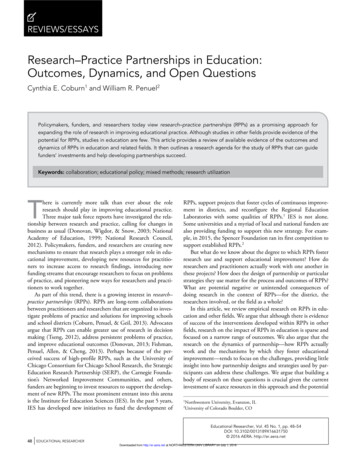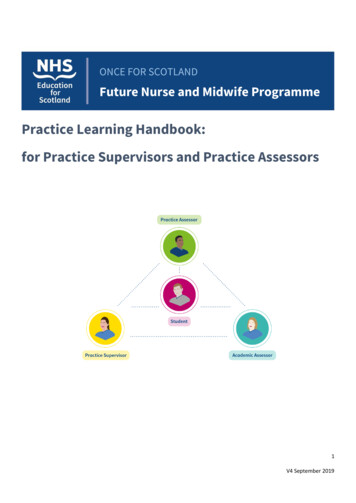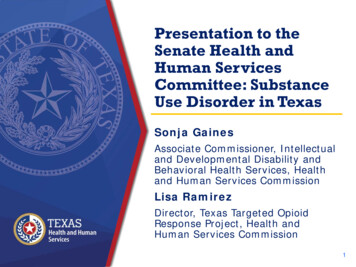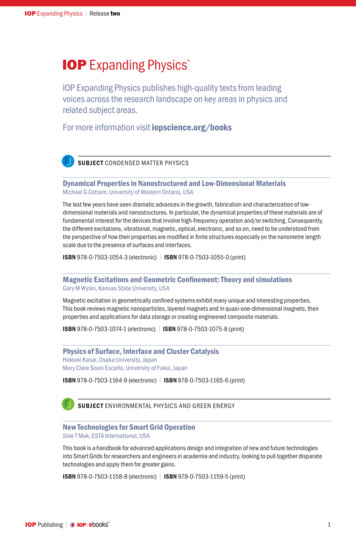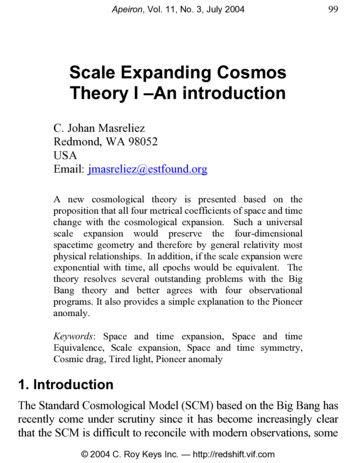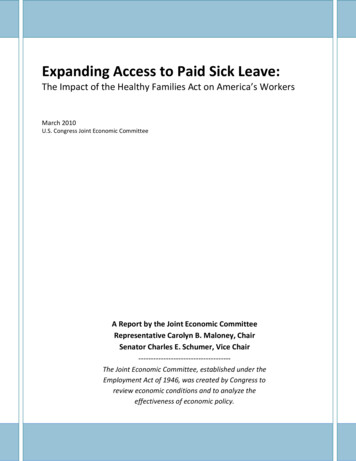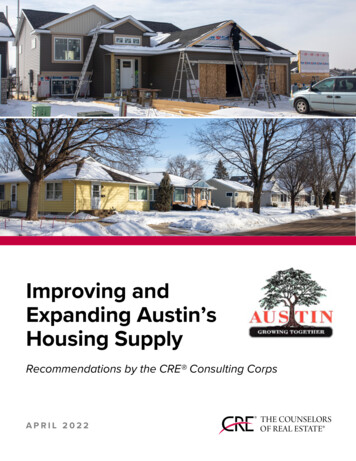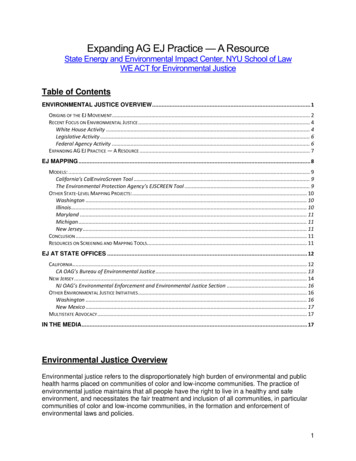
Transcription
Expanding AG EJ Practice — A ResourceState Energy and Environmental Impact Center, NYU School of LawWE ACT for Environmental JusticeTable of ContentsENVIRONMENTAL JUSTICE OVERVIEW. 1ORIGINS OF THE EJ MOVEMENT . 2RECENT FOCUS ON ENVIRONMENTAL JUSTICE . 4White House Activity . 4Legislative Activity . 6Federal Agency Activity . 6EXPANDING AG EJ PRACTICE — A RESOURCE . 7EJ MAPPING . 8MODELS: . 9California’s CalEnviroScreen Tool . 9The Environmental Protection Agency’s EJSCREEN Tool . 9OTHER STATE-LEVEL MAPPING PROJECTS: . 10Washington . 10Illinois . 10Maryland . 11Michigan . 11New Jersey . 11CONCLUSION . 11RESOURCES ON SCREENING AND MAPPING TOOLS. 11EJ AT STATE OFFICES . 12CALIFORNIA . 12CA OAG’s Bureau of Environmental Justice . 13NEW JERSEY . 14NJ OAG’s Environmental Enforcement and Environmental Justice Section . 16OTHER ENVIRONMENTAL JUSTICE INITIATIVES . 16Washington . 16New Mexico . 17MULTISTATE ADVOCACY . 17IN THE MEDIA . 17Environmental Justice OverviewEnvironmental justice refers to the disproportionately high burden of environmental and publichealth harms placed on communities of color and low-income communities. The practice ofenvironmental justice maintains that all people have the right to live in a healthy and safeenvironment, and necessitates the fair treatment and inclusion of all communities, in particularcommunities of color and low-income communities, in the formation and enforcement ofenvironmental laws and policies.1
Additional resources on defining environmental justice:Learn About Environmental Justice, Environmental Protection AgencyA Taxonomy of Environmental Justice, Robert KuehnEnvironmental & Climate Justice, NAACPOrigins of the EJ MovementThe environmental justice movement began as a grassroots movement spurred and driven bycommunity leaders and activists frustrated by poor environmental protection anddisproportionately high levels of industrial activity in communities of color and low-incomecommunities. The movement originated in 1982 in Warren County, North Carolina, when alandfill in the predominantly Black town of Afton was selected as the dumping ground for soilcontaminated with toxic polychlorinated biphenyls (PCBs) (Clifford Villa et al., EnvironmentalJustice: Law, Policy & Regulation, 3-4, 2020).Organized protests led by members of the community attracted the attention of elected officialsand national leaders on civil rights, environmental activism, and labor, many of whom came toNorth Carolina to join the protests. One of these leaders, Reverend Benjamin Chavis of theUnited Church of Christ Commission for Racial Justice, highlighted “environmental racism” asthe reason the toxic waste was being brought to the town of Afton, which was 84% Black andlocated in one of the poorest counties in the state. While the protests did not successfully stopthe dumping of PCBs in Afton, the demonstrations did provide the spark for the environmentaljustice movement as it is known today (Villa et al. at 4).The activism in Warren County gave rise to several studies and investigations that providedempirical evidence to support the decades of anecdotal evidence of the disproportionate burdenof environmental harms borne by communities of color and low-income communities. In 1983,the Government Accountability Office (GAO) released a report finding that three of four majorhazardous waste facilities in the Environmental Protection Agency (EPA) Region IV in theSoutheast were located in majority Black neighborhoods (GAO Report). In 1987, a studycommissioned by the United Church of Christ found that “race proved to be the most significantamong variables tested in association with the location of commercial hazardous wastefacilities” (UCC Report at xii).These foundational documents were essential in making the connection between race andadverse environmental impacts on human health, and underlined the need to act specifically toaddress the racialized impacts of environmental and health policies.Early activism also led to the First National People of Color Environmental Leadership Summitin Washington, D.C. in 1991, where grassroots activists drafted and adopted the 17 Principles ofEnvironmental Justice. These Principles play a fundamental role in defining environmentaljustice and outlining the key considerations for ensuring environmental justice is achieved. ThePrinciples are listed below.1. Environmental Justice affirms the sacredness of Mother Earth, ecological unity andthe interdependence of all species, and the right to be free from ecological destruction.2
2. Environmental Justice demands that public policy be based on mutual respect andjustice for all peoples, free from any form of discrimination or bias.3. Environmental Justice mandates the right to ethical, balanced and responsible uses ofland and renewable resources in the interest of a sustainable planet for humans andother living things.4. Environmental Justice calls for universal protection from nuclear testing and theextraction, production and disposal of toxic/hazardous wastes and poisons that threatenthe fundamental right to clean air, land, water, and food.5. Environmental Justice affirms the fundamental right to political, economic, cultural andenvironmental self-determination of all peoples.6. Environmental Justice demands the cessation of the production of all toxins,hazardous wastes, and radioactive materials, and that all past and current producers beheld strictly accountable to the people for detoxification and the containment at the pointof production.7. Environmental Justice demands the right to participate as equal partners at everylevel of decision-making including needs assessment, planning, implementation,enforcement and evaluation.8. Environmental Justice affirms the right of all workers to a safe and healthy workenvironment, without being forced to choose between an unsafe livelihood andunemployment. It also affirms the right of those who work at home to be free fromenvironmental hazards.9. Environmental Justice protects the right of victims of environmental injustice to receivefull compensation and reparations for damages as well as quality health care.10. Environmental Justice considers governmental acts of environmental injustice aviolation of international law, the Universal Declaration on Human Rights, and the UnitedNations Convention on Genocide.11. Environmental Justice must recognize a special legal and natural relationship ofNative Peoples to the U.S. government through treaties, agreements, compacts, andcovenants affirming sovereignty and self-determination.12. Environmental Justice affirms the need for urban and rural ecological policies toclean up and rebuild our cities and rural areas in balance with nature, honoring thecultural integrity of all our communities, and providing fair access for all to the full rangeof resources.13. Environmental Justice calls for the strict enforcement of principles of informedconsent, and a halt to the testing of experimental reproductive and medical proceduresand vaccinations on people of color.14. Environmental Justice opposes the destructive operations of multi-nationalcorporations.3
15. Environmental Justice opposes military occupation, repression and exploitation oflands, peoples and cultures, and other life forms.16. Environmental Justice calls for the education of present and future generationswhich emphasizes social and environmental issues, based on our experience and anappreciation of our diverse cultural perspectives.17. Environmental Justice requires that we, as individuals, make personal and consumerchoices to consume as little of Mother Earth’s resources and to produce as little wasteas possible; and make the conscious decision to challenge and reprioritize our lifestylesto ensure the health of the natural world for present and future generations.Source: United Church of ChristIn response to the growing grassroots movement, the EPA in 1992 established what wouldeventually be called the Office of Environmental Justice and convened the NationalEnvironmental Justice Advisory Council, which was tasked with making recommendations to theEPA on environmental justice issues (Villa et al. at 5). In 1994, President Bill Clinton signedExecutive Order 12898, a landmark Order that directed all federal agencies to incorporateenvironmental justice into their missions “by identifying and addressing.disproportionately highand adverse human health or environmental effects of its programs, policies, and activities onminority populations and low-income populations” (Executive Order 12898, § 1-101). The orderalso established the Interagency Working Group on Environmental Justice (EJ IWG), whichconvenes federal agencies to address critical environmental justice issues (Id. at § 1-102). TheEJ IWG is tasked with “assist[ing] communities in building the capacity to promote andimplement innovative and comprehensive solutions to address environmental justice issues”(EPA website).Under the administration of President George W. Bush, the obligation to focus ondisproportionate impacts based on race and income was deemphasized in favor of redefiningenvironmental justice to mean environmental protection for everyone (Villa et al. at 5).President Barack Obama’s administration placed renewed attention on communities of colorand low-income communities in the federal policymaking process. For example, in 2011, the EJIWG agencies adopted a Charter and signed the Memorandum of Understanding onEnvironmental Justice and Executive Order 12898 (MOU) (Charter; MOU). The MOU functionedas a formal agreement among federal agencies to “recommit to addressing environmentaljustice through a more collaborative, comprehensive and efficient process.” The Charter laid outa number of focus areas for the EJ IWG, including public participation, Title VI of the Civil RightsAct of 1964, Native Americans and Indigenous peoples, engagement with rural communities,and impacts from climate change. These efforts to refocus federal attention on addressingenvironmental justice diminished once again with the Trump administration (Villa et al. at 5-6).Recent Focus on Environmental JusticeThe Biden administration has committed to prioritizing and elevating environmental justiceissues across the federal government.White House Activity4
In his first week in office, President Biden signed an executive order entitled “Tackling theClimate Crisis at Home and Abroad,” which lists delivering environmental justice as an essentialpiece of the administration’s climate policy, and promises a whole-of-government approach toaddressing environmental justice issues (Executive Order No. 14008). The EO established twoWhite House councils — the White House Environmental Justice Interagency Council (WHEJIC)to develop the federal government’s strategy for addressing current and historic environmentalinjustice, and the White House Environmental Justice Advisory Council (WHEJAC) to adviseWHEJIC and the Council on Environmental Quality (CEQ) (Id. at § 220, 221). The EO alsoestablished the Justice40 Initiative, which sets a goal that 40 percent of the overall benefits offederal investments addressing climate change flow to disadvantaged communities (Id. at §223). In addition, the EO called for CEQ to create a Climate and Economic Justice ScreeningTool by July 2021 and for HEJIC to submit a set of recommendations for updating ExecutiveOrder 12898 (Id. at §§ 222(a), 220(b)).In May 2021, HEJAC released a report providing recommendations on Justice40, the Climateand Economic Justice Screen Tool, and revisions to EO 12898 (WHEJAC Report). The reporthighlighted the need to ensure a fair and just distribution of investments when administeringJustice40, and emphasized the importance of integrating and supplementing the Climate andEconomic Justice Screening Tool with local community knowledge and data (Id. at 40, 65).In July 2021, the Office of Management and Budget (OMB), CEQ, and the National ClimateAdvisor, in consultation with WHEJAC, released its interim implementation guidance for theJustice40 Initiative (Guidance Document). According to the guidance, covered programs andinvestments within the scope of the Justice40 initiative will fall into the following categories:climate change, clean energy and energy efficiency, clean transportation, affordable andsustainable housing, training and workforce development, the remediation and reduction oflegacy pollution, and the development of critical clean water infrastructure (Id. at 9). “Benefits”are defined as including “direct and indirect investments (and program outcomes) that positivelyimpact disadvantaged communities” (Id. at 4). When determining benefits to disadvantagedcommunities, the guidance highlighted that “agencies should consult with stakeholders,including state, local, and Tribal governments, as well as Native communities, to ensure publicparticipation and that community stakeholders are meaningfully involved in what constitutes the‘benefits’ of a program” (Id. at 7). The guidance provided some input on the variables toconsider when defining a disadvantaged community, such as income, racial and ethnicresidential segregation, and linguistic isolation, but indicated further guidance on this definitionwill be developed (Id. at 2-3).In addition, the guidance identified 21 federal pilot programs that will undertake an initialimplementation of the Justice40 guidance. Some examples of the pilot programs include theDepartment of Homeland Security’s Flood Mitigation Assistance grant program (FMA Grant),EPA’s Drinking Water State Revolving Fund (DWSRF) and Brownfields program (BrownfieldsProgram), and Housing and Urban Development’s grants for lead hazard reduction in homes(HUD). In developing implementation plans for these programs, the guidance directed agenciesto consider certain guidelines for modifying the programs in order to maximize benefits todisadvantaged communities, such as fostering well-paying jobs, conducting outreach, andavoiding potential burdens to disadvantaged communities (Guidance Document at 10). InSeptember 2021, the pilot programs submitted implementation plans for maximizing benefits todisadvantaged communities (White House Blog). By mid-December, agencies were expected tosubmit methodologies for calculating and tracking these benefits. The White House is5
developing a Scorecard to make this information available to the public, which is expected to bereleased in early 2022.Legislative ActivityThe administration and Congress also addressed environmental justice concerns through theCOVID-19 relief bill, which President Biden signed into law in March 2021. The bill includedspecific provisions for environmental justice grants to support communities facing disparateimpacts from the COVID-19 pandemic. The bill appropriated 50 million to “identify and addressdisproportionate environmental or public health harms and risks in minority or low-incomepopulations” and 50 million for air quality monitoring (H.R. 1319, § 6002). The legislation alsoprovided support to communities through additional funding for the Low Income Home EnergyAssistance Program, for water utility bill assistance to low-income households, and forcommunity health centers (Earthjustice; H.R. 1319 - § § 2911, 2912, 2601).The Build Back Better Act — which has passed the House of Representatives but not theSenate — includes over 160 billion to be invested in a variety of environmental justiceprograms (H.R. 5376; Equitable & Just National Climate Platform, Fact Sheet: EnvironmentalJustice Investments in the House Build Back Better Act). Proposed environmental justicespending includes: over 8 billion to reduce air pollution at ports and increase clean heavy-dutyvehicle use, 29 billion for the Greenhouse Gas Reduction Fund (which includes funding zeroemission technology in low-income communities), and 30 billion for the Civilian Climate Corps(providing jobs and training for the clean-energy economy) (Id. at §§ 30101, 30102, 30103,70202). Further, the Biden administration’s goal of delivering 40 percent of the infrastructureand climate investment benefits to disadvantaged communities will apply to the Build BackBetter Act (Equitable & Just National Climate Platform Fact Sheet).Federal Agency ActivityThroughout the first year of the Biden administration, federal agencies have been taking stepsto ensure they are engaging with and elevating environmental justice issues in a way that isconsistent with President Biden’s January 2021 executive order. For example, EPAAdministrator Michael Regan in April 2021 announced the following steps his agency will take toadvance environmental justice:Strengthening enforcement of violations of cornerstone environmental statutes and civilrights laws in communities overburdened by pollution.Incorporating environmental justice considerations into EPA’s work, including assessingimpacts to pollution-burdened, underserved, and Tribal communities in regulatorydevelopment processes and considering regulatory options to maximize benefits tothese communities.Improving early and more frequent engagement with pollution-burdened andunderserved communities affected by agency rulemakings, permitting and enforcementdecisions, and policies.Consistent with the Biden administration’s Justice 40 initiative, considering andprioritizing direct and indirect benefits to underserved communities in the development ofrequests for grant applications and in making grant award decisions, to the extentallowed by law.6
Source: EPA Press ReleaseIn October 2021, EPA published its draft strategic plan for fiscal 2022 through fiscal 2026, whichprioritizes advancing environmental justice and civil rights (Draft EPA Strategic Plan). Accordingto the draft plan, EPA’s “ultimate goal” of making this a priority is “to achieve measurableenvironmental, public health, and quality of life improvements in the most overburdened,vulnerable, and underserved communities.” In order to achieve this goal, EPA says it will “workto increase the capacity of communities and Tribes working to address environmental justiceand civil right concerns; embed environmental justice and civil rights in the Agency’s core work;and strengthen civil right enforcement in communities overburdened by pollution” (Id. at 20).EPA also addressed environmental justice concerns through rulemakings released in 2021. Forexample, EPA considered the effects of climate change, hazardous air pollutants, and economicimpact through the lens of environmental justice as it relates to the hydrofluorocarbons (HFC)phasedown (Beveridge & Diamond). In November 2021, the EPA published a final rule toimplement certain provisions of the December 2020 COVID-19 relief and spending legislationthat initiated the phasedown of HFCs, a potent greenhouse gas (86 Fed. Reg. 55116 (2021)).The rulemaking specifically addressed how EPA considered environmental justice concerns inits analysis, noting the higher percentage of low-income and Black communities located nearHFC production facilities and the health risks associated with living near these facilities (Id. at55127).At the Department of the Interior (DOI), Secretary Deb Haaland in April 2021 signed aSecretarial Order aimed at “restoring transparency and integrity to the [Department’s] decisionmaking processes,” and specifically highlighted environmental justice as an area of focus in theagency’s efforts to address climate change (Secretarial Order No. 3399). In DOI’s November2021 report on the federal oil and gas leasing program, the agency called for “creating a moreinclusive and just approach to managing public lands and waters” (DOI Report). Certainpractices within the leasing and permitting process can leave out local community voices,especially Tribal voices, thus DOI recommended “undertak[ing] meaningful Tribal consultationsand solicit[ing] public input more generally regarding its leasing and permitting processes” (Id. at14).The Federal Energy Regulatory Commission (FERC) in May 2021 appointed Montina Cole to anewly established position entitled Senior Counsel for Environmental Justice and Equity in aneffort to more effectively incorporate environmental justice and equity concerns into FERC’sdecision-making process (FERC Press Release). In July 2021, the Nuclear RegulatoryCommission (NRC) released a request for comments as part of a “systematic review for howNRC programs, policies, and activities address environmental justice” (86 Fed. Reg. 36307(2021)).Expanding AG EJ Practice — A ResourceEnvironmental justice is a key aspect of the just transition to a clean energy future. As thenation’s economy moves away from fossil fuels and toward renewable energy, it is essential thatenvironmental justice communities are prioritized and included in this process. With such afundamental transformation coming, the communities that have, for decades, borne the brunt ofenvironmental and public health harms cannot be left behind (CBS News). State attorneys7
general have an important role in enforcing these principles in partnership with the affectedcommunities.The State Energy and Environmental Impact Center has developed this resource in partnershipwith WE ACT for Environmental Justice to provide key information to state attorney generaloffices and others interested in expanding their work in the environmental justice practice area.This resource provides information on mapping tools for identifying environmental justicecommunities and gives background on attorney general sections and initiatives dedicated toenvironmental justice work. The resource will be continually updated. Please contact BethanyDavis Noll (bethany.davisnoll@nyu.edu) for more information.EJ MappingAs environmental justice activism and policy work continue to progress, local, state, and federalprograms must first identify environmental justice communities.As defined by EPA, environmental justice communities (EPA uses the term “overburdenedcommunities”) are those minority, low-income, Tribal, or indigenous groups that aredisproportionately burdened by the cumulative impacts of environmental abuse (EPA website).This concept of cumulative impact refers to the negative public health, environmental, and socialeffects that result from the combined exposures to pollution and improper land use that EJcommunities are often subject to in this country (Lee, 2020). By tracking areas experiencingcumulative impacts, advocates have been able to identify the communities that are faced withconsistently disproportionate environmental and social stressors, and work to better recognizeand follow the proper path towards resolving the environmental issues that affect thesecommunities (Morello-Frosch et al., 2011).In order to address the environmental inequities of cumulative impacts, advocates must first beable to understand where they exist. The process of EJ mapping, first described by theCommission on Racial Justice’s 1987 report Toxic Wastes and Race in the United States, wasintroduced as a tool for identifying the location of EJ communities and gathering directinformation from the experiences of people living with the burdens of pollution (UCC Report).While this first step of locating vulnerable communities exposed to high levels of pollution was acritical part of EJ advocacy and promoted more public participation, it did not guaranteesustained government action.More recently however, technological advances have empowered the resurgence of EJmapping tools. Over the last decade or so, combined with renewed focus on environmentaljustice at multiple levels, these newer tools have helped government agencies better confrontthe problem of disproportionate cumulative impacts in EJ communities.The newer tools include digital mapping programs, Geographic Information Systems, and datacollection tools like air quality monitors. By using mapping to overlay data about environmentalburdens with community demographics and vulnerabilities, EJ community members andorganizations can now show a direct relationship between public health and harmfulenvironmental conditions. This evidence in turn enables EJ communities to press governmentagencies to pay attention to over-burdened areas and to take action on issues that contribute tocumulative environmental inequity. Access to these visual and data-based mapping toolsprovides EJ communities the validation and power needed to combat environmental hazards intheir areas. The tool also plays a key role at government agencies as they seek to make8
environmental justice work central to their advocacy. In this section, we describe the tools thatare available.Models:California’s CalEnviroScreen ToolCalifornia led the way for states by recognizing the importance of EJ mapping tools in prioritizingdecision making and community protection actions. It became the first state to deploy a widelyaccepted EJ map with its CalEnviroScreen tool, which was made accessible to the public byCalEPA’s Office of Environmental Health Hazard Assessment in 2013 (CalEnviroScreen). Thistool was developed with the help of significant community participation, and features 21indicators divided into four categories: exposure, environmental effects, sensitive populations,and socioeconomic factors. The data from these indicators is combined to calculate a peerreviewed cumulative environmental health score for each census tract in the state. This scoringprocess gives users the ability to identify EJ communities based on pollution exposure, health,and socioeconomic vulnerability.Local California governments and organizations have widely accepted the CalEnviroScreentool, which is currently in its fourth version and continues to be improved and updated byCalEPA and other state agencies. CalEnviroScreen data sets are more in depth than thenationally consistent data used by the EPA’s EJSCREEN tool. Partnering groups, such as localschools and independent businesses conduct their own research to assist the state agencies inidentifying relevant indicators and demographics for the mapping tool. CalEnviroScreen is nowu
Expanding AG EJ Practice — A Resource State Energy and Environmental Impact Center, NYU School of Law . adverse environmental impacts on human health, and underlined the need to act specifically to . In July 2021, the Office of Management and Budget (OMB), CEQ, and the National Climate .


